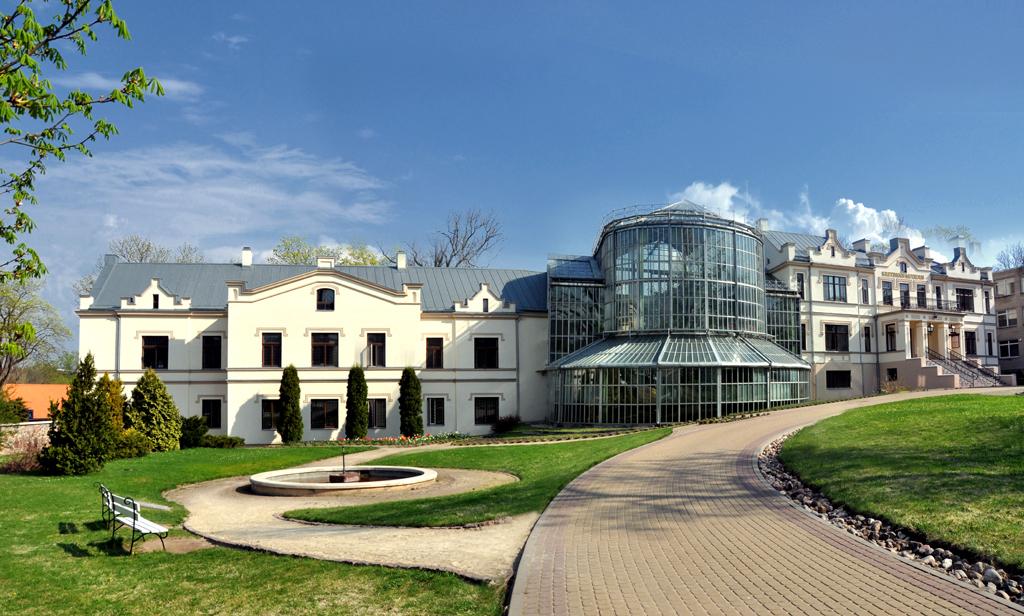The count Tiškevičius residence in Kretinga

The tour is meant for all, who are interested in the history of the Tiškevičius Manor and the Tiškevičius family. The Kretinga Manor Mansion, which was established in the 16th century, is the beginning of the spectacular journey through the ages, specifically the 19th century.
The Manor Mansion is a three building complex, which includes the mansion itself, presently housing the Kretinga Museum, the conservatory and Winter Garden, which was the biggest private conservatory during the 19th century, and the wing, which was where the Counts lived. Today, the Manor Mansion is separated from the other two buildings by Vilniaus street. A small white structure catches the eyes of those who cross the street. Behind it stands a shabby red brick building. The two buildings seem rather different, but they were once a part of the same complex – the Greenhouse of the Manor. The renovated part presently houses the Centre of Traditional Crafts and the Kretinga Museum cash desk.
The large red brick building next to the former Manor Greenhouse used to be the Manor Garage, where the luxurious manor chariots were built, and for some time, it used to serve as the coconut oil mill.
Near the garage on Vilniaus street stands a renovated red building – the former Kretinga Manor Mill, which is the first hydro-power plant in Lithuania. During the interwar period, the mill was where oil, syrup and sweets were produced. Today, the structure has been converted to house exhibits and educational activities.
Beyond the dam bridge, opposite the first Manor Park Pond lies a grey stone building. This was the Manor Housekeeper’s Home, renown for its mysteriously beautiful and well crafted antique style frescos. A mosaic can be found on the northern wall of the building with a date written with pebbles. Can you find it?
Advancing down the curve of Vilniaus street, one shall see a brick Prussian style building, which previously served as the spirit distillery and brewery. Next to it stands a stone fence circling around a green meadow, which is the 16th–17th century Kretinga and Padvariai Cemetery.
The tour through the Kretinga Manor Park continues by crossing Vilniaus street and walking down the pathway along the pond. The Lookout Hill and the Waterfall Cave stands on the left, while the arch walking bridge can be found on the right. Beyond the walking bridge that connects the First and the Second Ponds, one can walk by the Isle of Love, located at the shore of the Second Pond right up to the walking bridge that connects the Second and the Third Ponds. From here, one can see a bright red brick building standing on the promontory of the Second Pond. This is the Manor Hospital, where Marija Tiškevičiūtė, the sister of the Count, has established the first Lithuanian kindergarten for the residents of the manor.
From the bridge connecting the First and Second Ponds, one can see the sporting grounds, the children’s playground, and the swimming area at the shores of the Third Pond. This is also the path that leads back to Vilniaus street at the buildings of the Manor, where the tour started.
It seems like this is where the tour around the Manor should end, but the legacy of Count Tiškevičius stretches a bit more, up to the New Kretinga Parish Cemetery (or the II Old Cemetery), so the journey continues down Vilniaus street along the old stone Manor Park fence towards the centre of the city. Having crossed the Šiaulių-Palangos road and Savanorių street and continuing through the strip with the cemetery on both sides, the tour continues until the cemetery fence on the left side of the street, along with the Northern and Southern Gates and the beautiful Chapel-Mausoleum, which was built by Aleksandras Tiškevičius and where the Tiškevičius family is now resting.
This is the last landmark within the 2-hour and 3.5-kilometre long tour. Unfortunately, the tour ends here, but those wanting to know more of the Tiškevičius family can revisit and take a closer look at the landmarks in the Kretinga Manor Park and the Kretinga City Centre.